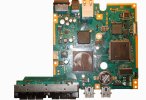The one thing that amazes me regarding the PS2 is the fact that the 'bump/normal map hunt' is still ongoing after 19 years of existence. Its clear to me that the PS2 wasnt that well suited for the use of bump, normal or any of those kind of effects in games, not in any way. Geotexturing or pure polys or not, whenever it was used it was very subtle in the handful of titles that had it.
Perhaps more impressive for the PS2 was the use of spherical harmonic lighting in SotC.
Btw, we all know how chaos theory turned out on ps2,
Lot's of power, just little context that in some ways was too hampered by it's implementation. I'd like to wonder if Sony was even really paying attention to graphics in the PC space before they taped out the Graphics Synthesizer. It's clear they were all about the polys and special effects (and numbers to fluff the press & public) but not some of the finer points to clean image rendering like the Dreamcast.
Other things bother me like how bolted-on Vector Unit 0 was, and consequently went generally unused. Being a coprocessor (CP2?) to the MIPS CPU hampered it's ability to assist in graphics, and it's small caches made it difficult to work with for other things IIRC. I wonder if the FPU could've been ditched for VU0 with an expanded cache. Might've made it possible to afford a bit more die space for a third VU to operate in parallel with VU1.



